In many European cities, the usual tourist path involves visiting at least one spectacular church in each city. But that’s not necessarily the case in Denmark .
That is, a lot of people don’t seem to equate Copenhagen with churches. This is despite the fact that the Danish capital has a number of really beautiful churches and cathedrals that are often packed with history.
Fortunately, many of them are located in the center of Copenhagen, making it very easy for you to visit at least some of them as part of your discovery of this incredible city – even if you didn’t plan to at first.
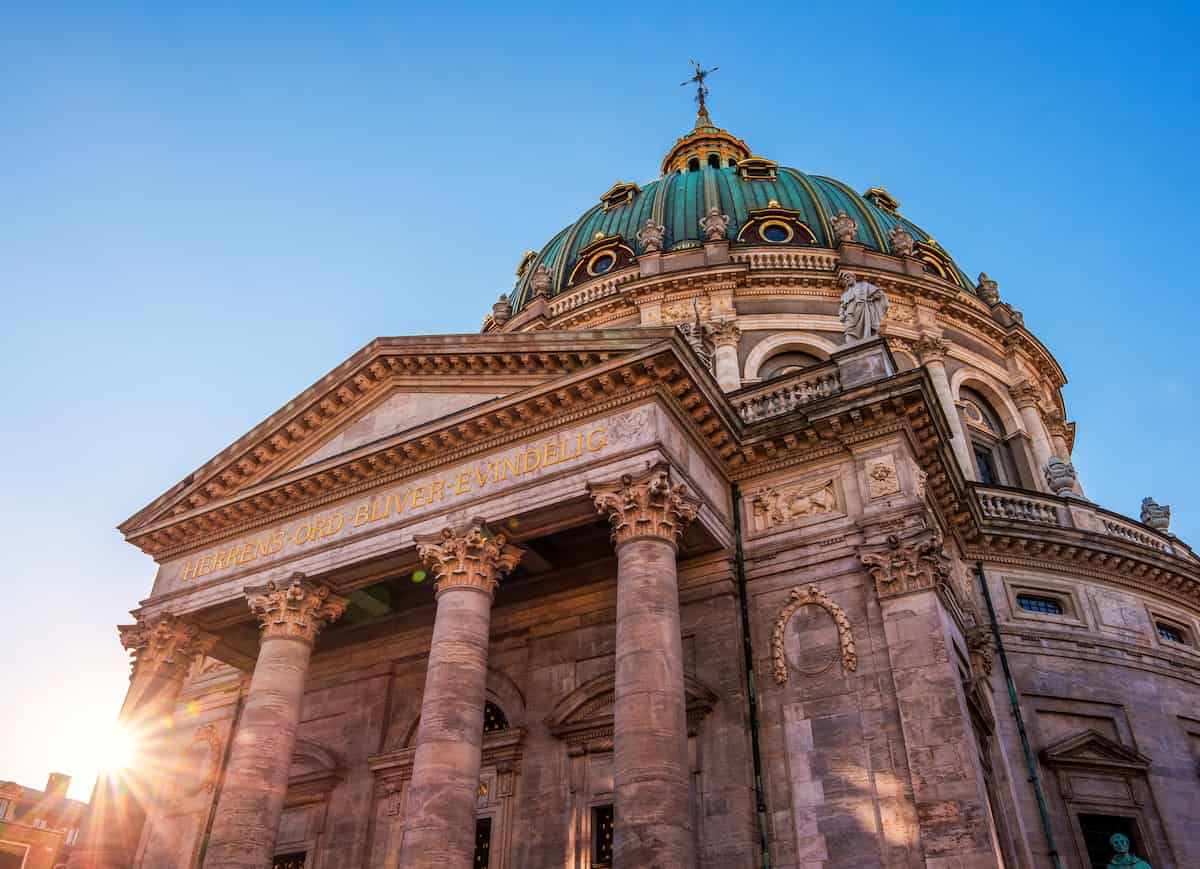
Table of Contents
Best Copenhagen churches to visit
1. Vor Frelsers Kirke (The Church Of Our Savior)
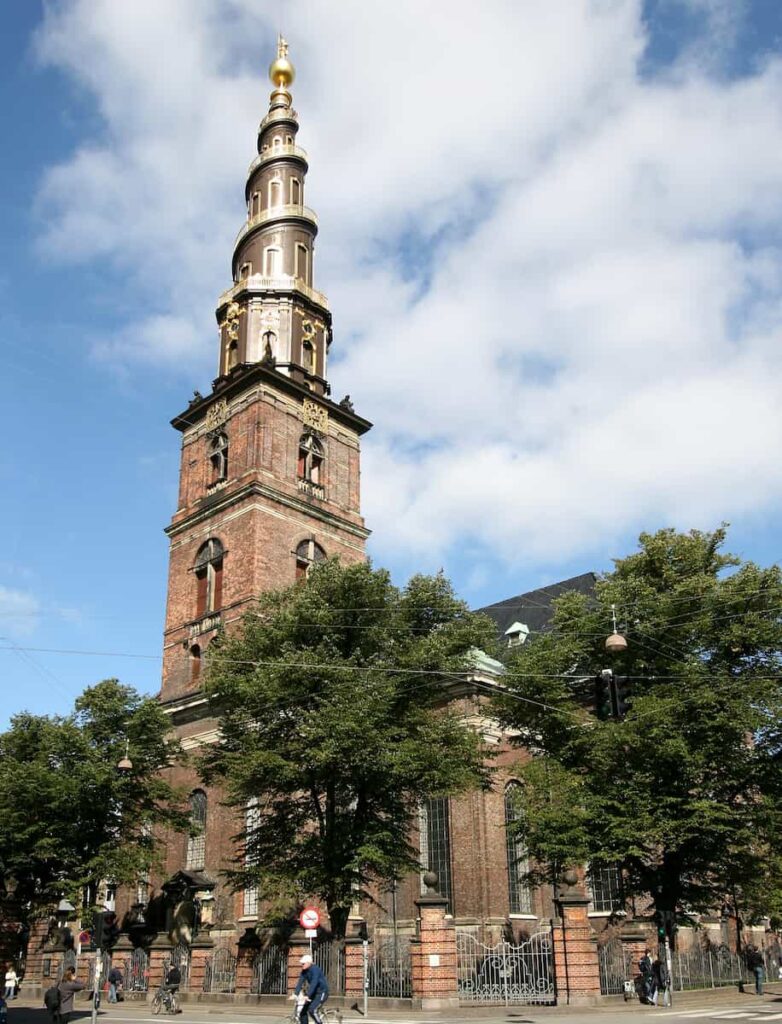
The Church of Our Savior in Copenhagen is one of the top tourist attractions in the capital – and for good reason. This famous Copenhagen church spire is about 300 feet (90 meters) tall and if you make the effort to climb it, you’ll be rewarded with one of the best views in the city.
The church was consecrated in 1696, with construction having started in the 1680s. It’s a beautiful example of baroque architecture, but there’s no question that the spiral spire is the main feature.
You will have to climb 400 steps to get there, 150 of which are on the outside, so make sure you pick a day where the weather doesn’t make that too painful.
But before you get to the spire that Denmark is famous for, it’s also worth taking a look inside the church. Keep an eye out for various elephant symbols, which you wouldn’t normally see in a church, but which are emblematic of the order of the elephant in honor of King Christian V, during whose reign the church was built.
You may also be interested in: 9 Best Mermaids of Denmark (That You Need to See)
2. Marmorkirken/Frederiks Kirke (The Marble Church/Frederiks Church)
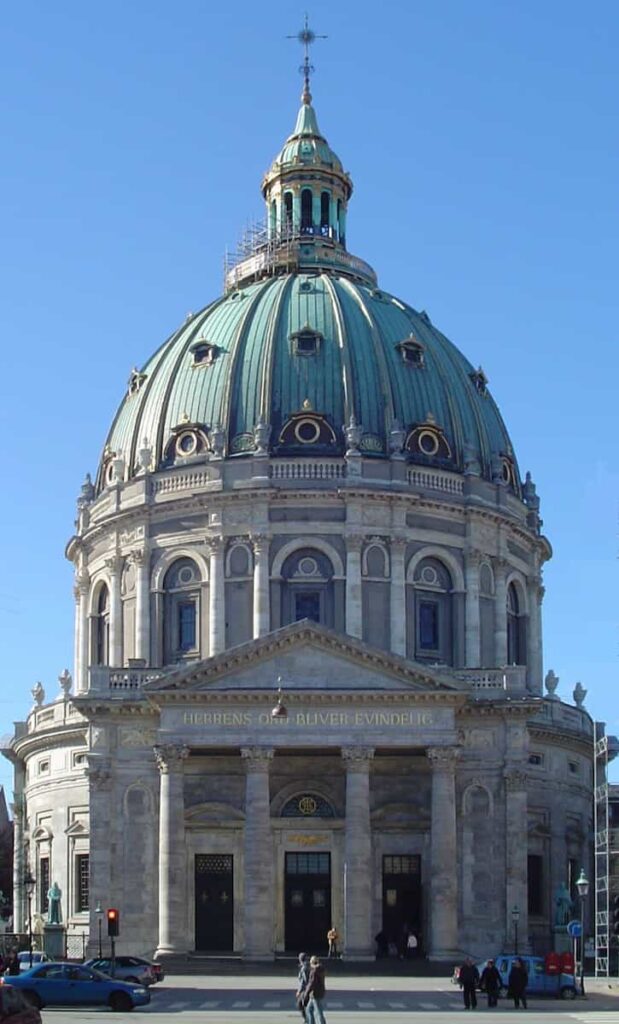
No trip to the Danish capital is complete without visiting Amalienborg Palace, the official residence of the Queen of Denmark in the city. But turn around and look straight in front of you, where you’ll see one of the most spectacular churches in Copenhagen, if not the whole country .
That is, the Marble Church (also known as Frederick’s Church) is most easily identifiable by its impressively large green dome on top. This stands proudly over the skyline of the city, but inside of this church is definitely worth a visit as well.
While most people know this as the Marble Church, that’s actually the unofficial name. This comes from the fact that the church was built with Norwegian marble, with construction having been started by King Frederik V in 1749. It ended up taking over 100 years for construction to be finished though, meaning it’s not actually one of the oldest churches in Copenhagen.
This doesn’t make it any less beautiful though and it is possible to visit the church at certain times of the week, which you should absolutely try to do. Just make sure you check the website before visiting to be sure that it’s open, as sometimes it will be closed to visitors if an event is on.
Related: Danish vs Dutch: Are They The Same? (+ All the Differences)
3. Sankt Aleksander Nevskij Kirke (Alexander Nevsky Church)

One of the benefits of the Danish royal family having intermarried with other European royals throughout history is that we get some nice little surprises scattered throughout the kingdom. One of these is the Alexander Nevsky Church, which was paid for by Tsar Alexander III on behalf of his wife, the former Princess Dagmar of Denmark.
This is the only Russian Orthodox church in Denmark, having been constructed in the 1880s. However, Russian Orthodox services were actually held in Copenhagen for more than 100 years prior.
What makes this church stand out is its architecture, which is modeled off Moscow architecture from the 17th century. The glistening gold onion shaped domes give this away, which certainly stand out in between the more traditionally Scandinavian architecture of the buildings surrounding it.
Visiting hours are quite limited for this church, so if you want to visit, check the website and plan accordingly.
Find out more: 9 Best Cities to Live in Denmark (For Your Best Life)
4. Trinitatis Kirke (Trinity Church)
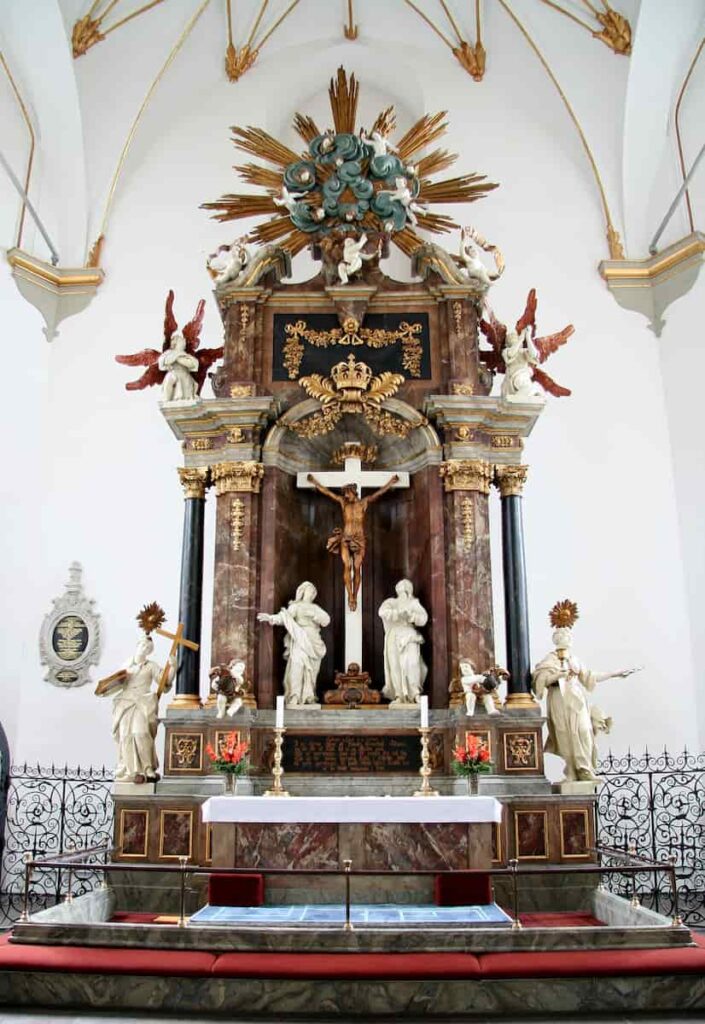
The Round Tower (Rundetaarn) in the center of Copenhagen is definitely worth a visit due to the views on offer, but the Trinity Church next door shouldn’t be missed either. It’s actually attached to the Round Tower and is closely associated with the former university library next door .
Construction originally started on this church in 1637 by King Christian IX of Denmark. In fact, the king himself was involved in planning the design of the church, in line with his belief that knowledge and justice were paramount.
In 1728, the city experienced the great fire of Copenhagen, with the church being severely damaged. It was eventually rebuilt and has also been restored at various times over the years. Now, it is known for being a great location for various musical events, and not only those with religious significance.
In fact, if you manage to catch them at a time when someone is playing some of this church’s spectacular organs, count yourself lucky as it’s really stunning to hear.
Related: Stockholm vs Copenhagen: Which Is Better to Visit?
5. Vor Frue Kirke (Church of our Lady – Copenhagen Cathedral)

Copenhagen Cathedral may not seem as grand as the cathedrals you’ll find in other European capitals, but don’t mistake that as meaning that it doesn’t have any significance.
This has actually been the location of a church in Copenhagen since 1209, with the ruins under the cathedral even being able to be visited at certain times of the year.
It’s right in the center of the city, so it’s very easy to visit as you’re wandering around during the day – and it’s free, for an added benefit.
And for anyone who is a follower of the current European royals, you may be interested to know that Copenhagen Cathedral is where, in 2004, Crown Prince Frederick married his Australian bride, the now Crown Princess Mary. A modern day fairytale in the land of Hans Christian Andersen!
6. Christiansborg Slotskirke (Christiansborg Palace Chapel)

Christiansborg Palace is a huge, impressive set of buildings framed by canals in the middle of Copenhagen. It’s not only a palace, but also includes government buildings – and, in one corner of the complex, is the Christiansborg Palace Chapel.
A church has been standing here since 1167, when the castle of Bishop Absalon was erected on what was then a small island outside Copenhagen harbor.
However, after a number of fires in Copenhagen, the interior of the church is much more modern than what you would expect from a nearly 900-year-old building. In fact, the last fire was in 1992 when fireworks landed on the roof of the chapel, causing extensive damage.
Nevertheless, the overall design of the chapel is in line with its historical design. Further cementing its place in history is the important role that Christiansborg Palace chapel has played for the Danish royal family. Most recently, the baptisms of the three children of the crown prince and princess of Denmark were held here as well as the funeral of Prince Henrik, the husband of Queen Margarethe.
7. Holmens Kirke (Holmen’s Church)
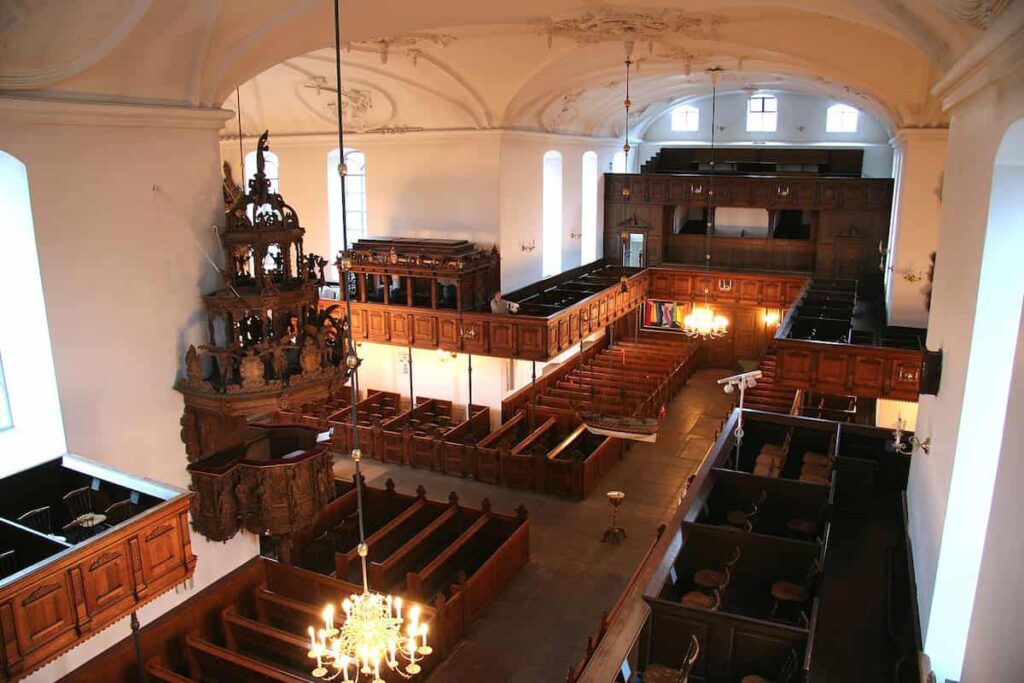
Funnily enough, this Copenhagen church was originally a workshop for creating anchors in the mid-1500s. However, King Christian IV decided that the Royal Marines in the area needed their own church, allowing the workshop to be changed to a more religious usage.
And I’m not exaggerating: although Holmen’s Church was consecrated in 1619, structurally, it remained very similar to its original workshop.
It was expanded over time and, today, it’s considered the church of the Danish royal family. This can be seen by the fact that the current Queen and her husband married here in 1967 and Crown Prince Frederick was baptized here one year later.
If you plan to wander the canals of Copenhagen, you’ll definitely pass this beautiful example of baroque architecture. If you wish to enter though, it’s usually open in the middle of the day.
Try to time your visit to be on a Wednesday at lunch time, as if you’re visiting in summer, you may be lucky enough to catch one of the church’s weekly organ concerts.
8. Helligåndskirken (Church of the Holy Spirit)
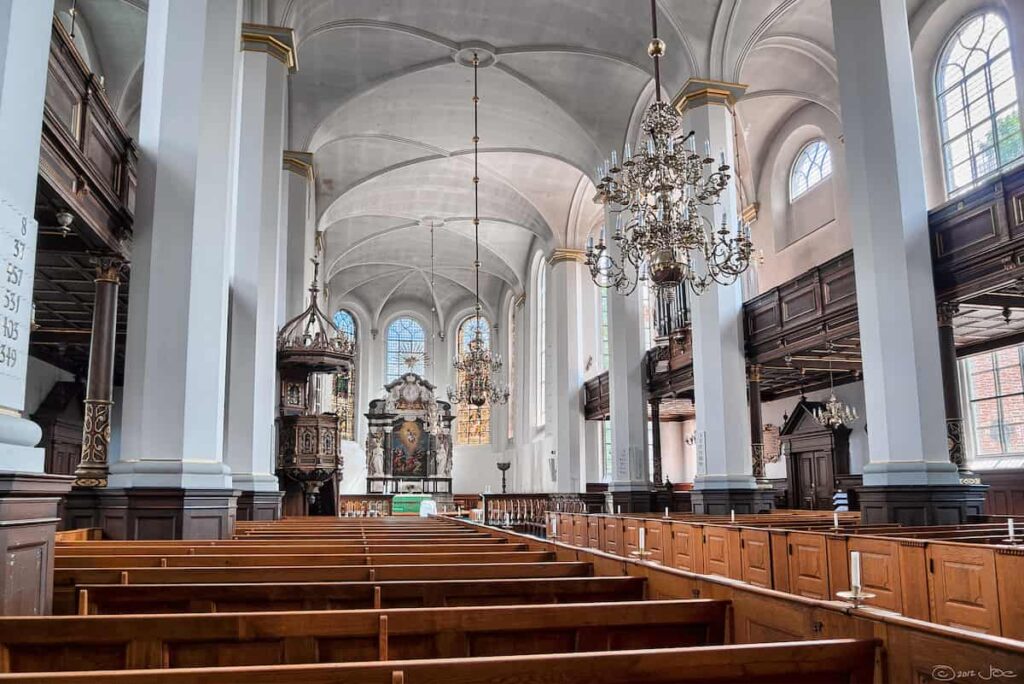
No visit to Copenhagen is complete without a stroll down Strøget (…just so you don’t miss that amazing pun, the Danish word “Strøget” is pronounced quite closely to how we say “stroll” in English. Because we all know puns are just as funny when you have to explain them), the famous pedestrian shopping street.
And fortunately, you can easily combine this with a visit to another Copenhagen church, with the Church of the Holy Spirit being located basically at the midway point of this street.
Much like many of the other Copenhagen churches on this list, this one has been damaged by fire at various times throughout history. Nevertheless, the church remains a clear example of baroque architecture.
It has a beautiful combination of some of the simpler features you see in many Danish churches along with some spectacular stained glass windows. Overall, it’s definitely worth a detour from your shopping trip (don’t worry, you can soon go back to your mission to find your favorite product from your preferred Danish shoe brand).
9. Grundtvigs Kirke (Grundtvig’s Church)

This church isn’t quite as centrally located in Copenhagen as some of the others on this list, but I would still recommend making the trip to see it if you have time.
The church itself is relatively new, with construction having been finished in 1940. You may have an initial inkling that it isn’t that old when you first see it, as it does lack some of the features you would normally see in a church, like gold-leafed statues and stained glass windows.
But this doesn’t make it any less impressive, with the architecture revealing soaring ceilings and imposing columns that easily makes this Copenhagen church just as grand as some of its older cousins.
One extra benefit of visiting this church is that it’s directly opposite Bispebjerg cemetery. As with other cemeteries in Copenhagen, this one is regularly used by people to have a picnic or just chill out in the natural surroundings.
It may sound strange, but given the number of trees, gardens and paths, it’s a really relaxing place to spend an afternoon. And if you manage to time your visit during April, you’ll be lucky enough to see lines of cherry blossoms that make for some beautiful imagery.
10. Sankt Ansgars Kirke (St Ansgar’s Cathedral)
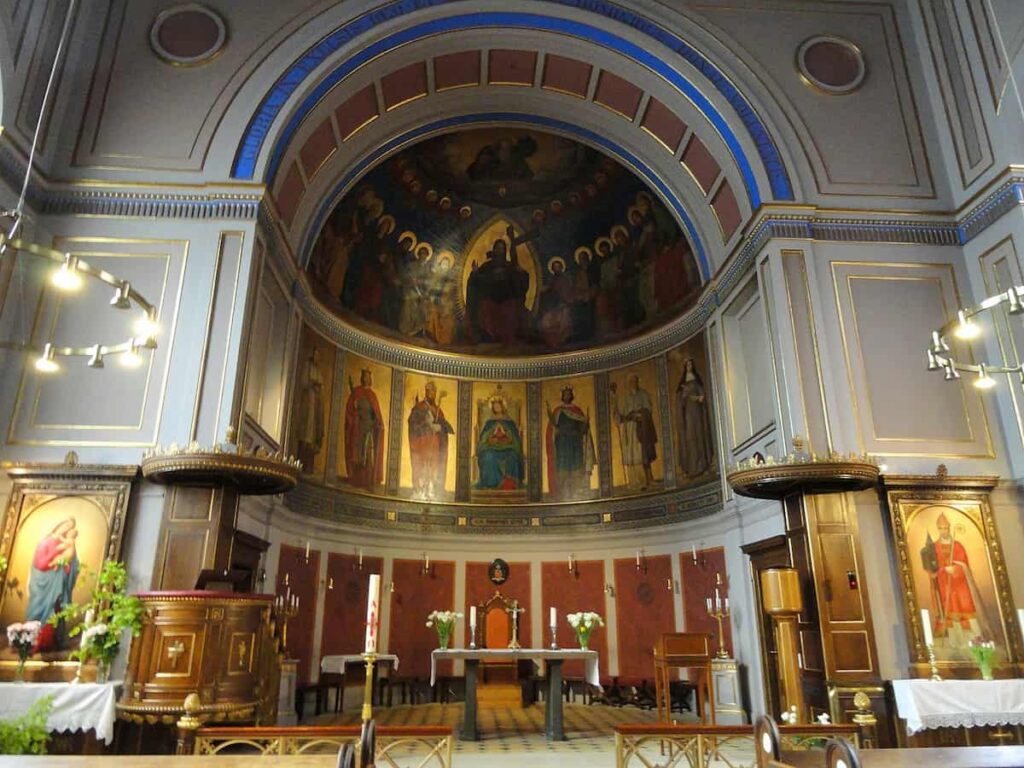
Ansgar of Bremen was known as the “Apostle of the North”, having been one of the earliest missionaries in Sweden and Denmark in the 9th century. He’s honored through the name of this Copenhagen church, which is the cathedral of the Roman Catholic diocese in what is actually one of the geographically largest jurisdictions in the world.
That is, it covers not only Copenhagen but the rest of Denmark. This means that it also includes the Faroe Islands and Greenland and so is definitely considered one of the most important churches in Copenhagen.
It was actually financed partly by empress Maria Teresa, who wanted to provide somewhere for the staff of the Austrian embassy in Copenhagen to worship.
This led to its construction being started around 1840, leading to the church you see today. It’s perhaps not the most spectacular one you’ll find on the outside, although its red brick facade and neoclassical architecture do have a certain appeal. However, go inside and you’ll see that this is really impressive, especially the apse of the church that greets you once you enter.
11. Christians Kirke (Christian’s Church)
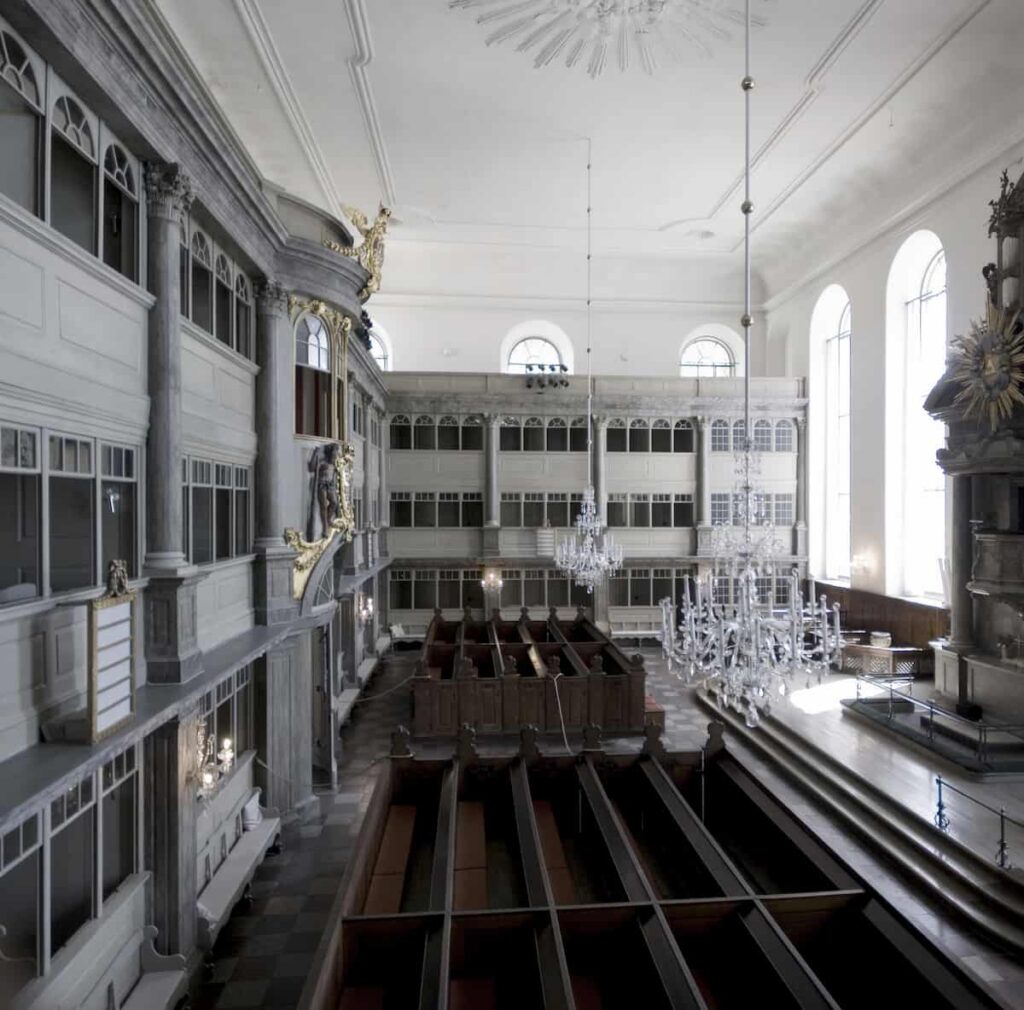
I love taking people to see Christian’s Church as it’s nothing at all what you would expect. The first impression you get as soon as you walk in is that it sort of feels like a theater, with three of the walls consisting of what look like viewing boxes at an opera house, although perhaps not as fancy.
And this is exactly why many people refer to this as the “theater church”. At the same time, you would expect some color in most theaters – but not here.
Instead, the entire building seems basically monochrome, which is especially startling if you’ve been visiting other churches with the bright colors being thrown off their stained glass windows .
Don’t get me wrong though, this is still a church. It was originally constructed in the mid 1750s but closed in 1886. Fifteen years later, it reopened as a Lutheran church.
However, in line with its nickname, you’ll often find shows being put on here. It’s a really cool experience if you get to go to one and, for a relatively unassuming building, the sound is spectacular.
12. Sankt Petri Kirke (St Peter’s Church)

This Copenhagen church is another one that is right in the middle of the city and which you’ll definitely cross while wandering around the older center of town.
It was actually one of four Catholic churches in Copenhagen during the Middle Ages, with it being believed that it was founded in the 12th century. Its history is further reinforced by the fact that it remains the oldest building in central Copenhagen.
(And it’s literally mere steps from the oldest bakery in Copenhagen, where you should definitely try to get some Danish bread and pastries to fuel your tour of this church.)
However, over the years, there have been a number of additions made to the church, with various annexes and towers being added throughout the centuries.
King Frederik II offered the church to the German speaking community in 1585 and it actually remains as such today. You can even still attend Mass here in German if you want, but even if you just wish to visit to admire the building, you’re more than welcome to do so.
With all of the expansions throughout the church’s history, along with a beautiful garden behind the church, walking around the building is a really lovely experience.
Related: How Far Is Denmark From Germany?
What is the oldest church in Denmark?
The oldest church in Denmark is Ribe Cathedral, also known as Our Lady Maria Cathedral, located in the city of Ribe in southern Jutland. It was established during the Viking Era as the first Christian church in Denmark in the year 860.
It was actually established by Ansgar, the missionary I mentioned earlier. While King Horik I wasn’t Christian himself (in fact, he was a pagan), he was supportive of Ansgar’s efforts, even helping to support a missionary expedition to Sweden.
The city of Ribe itself is the oldest city in Denmark and, for that reason, is worth a visit, although you could also combine it with visiting any of the nearby Danish fjords. The Cathedral is the main focal point of the town, but there are plenty of other examples of the city’s long history that you’ll notice as you start wandering around.
Find out more: 11 Best Places in Denmark For Viking Experiences
What to wear when visiting churches in Copenhagen
Most churches in Copenhagen don’t have a dress code, although it’s always a good idea in any country when entering any house of worship to be respectful to those who may be in attendance to pray.
That said, in all honesty, the weather in Denmark doesn’t really give rise to an option to wear clothes that may cause a problem in church as can be the case in other countries. After all, if you have to wear a jacket basically every day of the year, no one can take issue with that.
As such, it’s very unlikely that there will be any problems with what you’re wearing if you choose to pop into a church in Copenhagen as you’re passing by.
